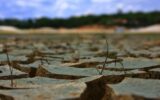40% of Iran’s aquifers will never be restored

According to the Energy Press report, Dariush Mokhtari said about well drilling and its effect on the aggravation of underground water problems: Until 1999, our technologies were mostly limited to extracting water from aqueducts, and water for cities, villages, and agriculture; It was supplied from aqueducts, springs, and rivers, that is, water was transported by gravity, and dams were built locally and water was transferred. For example, we have 12 traditional dams on the Ker River, in such a way that they raised the water level and diverted it into the traditional irrigation network, that is, we did not have pump technology in supplying water to agriculture, cities and villages, and everything was based on gravity and weight. Until the pump technology entered the country in the 1310s, and it expanded in the 30s and 40s to the 50s, and in these three decades, the number of drilled wells reached 200,000 rings.
He continued: In the 1960s and 1970s, an average of 100,000 wells were drilled every year, and now we have reached one million wells, of which 400,000 are low-efficiency and unauthorized wells and 600,000 are active wells, both deep and semi-deep. And they are superficial.
This water expert stated: When pump technology entered the country in the 1930s, villages were supplied with water using pump technology. These diesel wells made people happy because the aquifers were full of water. We had artesian wells in the north of the country and even in the eastern part of Marvdasht. That is, the water from the well gushed out and reached the surface of the ground and did not need to be dug. In addition, this issue occurred at the same time as the land reforms, which means that the land was distributed with the view of social justice, and the land was taken from the owners and given to small owners in smaller pieces. In this arrangement, each of the small farmers applied for drilling wells, in other words, part of the current number of wells in the country was the product of the land reform policy, which actually added to the number of requests, the dispersion of land also added to this story and the wastage of water resources was widespread, while the time The feudal lord dug the well and distributed the water hourly, but when the lands were fragmented, each landowner dug his own well, in other words, part of the large number of wells was related to this law along with pump technology.
He said: In 1342, we had the water law and how to nationalize it. In fact, despite its name, this law nationalized water, that is, we went towards the licensing program, while until 1342, water was nationalized. After this action, everyone tried to access water. This renewable source inside the ground and aquifers should be the first, because according to the rule, whoever is older has a higher license and is ahead of the next ones, in this way, with this competition we organized, we reached one million wells, the result of which was destruction and It is the destruction of Iran’s aquifers.
Mokhtari pointed out: Now, if we look at the aforementioned measures as a policy package in the context of development, we have relied on agriculture since the 60s, and relying on agriculture has meant more exploitation of aquifers, and the view of self-sufficiency and encouraging wheat cultivation to increase demand. It encouraged the digging of wells, that is, this discourse prevailed in the 60s and intensified during the Ahmadinejad period, that is, the production of 14 million tons of wheat in the country was considered one of the honors and positive performance of the government, and despite the addition of this cultivation, it is still An average of 7 million tons are imported every year.
Tags:aquifers ، iran ، Water ، water crisis
- Comments sent by you will be published after approval by site administrators.
- Comments that contain slander will not be published.
- Comments that are not in Persian or not related to the news will not be published.

Comments
Total comments : 0 Awaiting review : 0 Date: 0